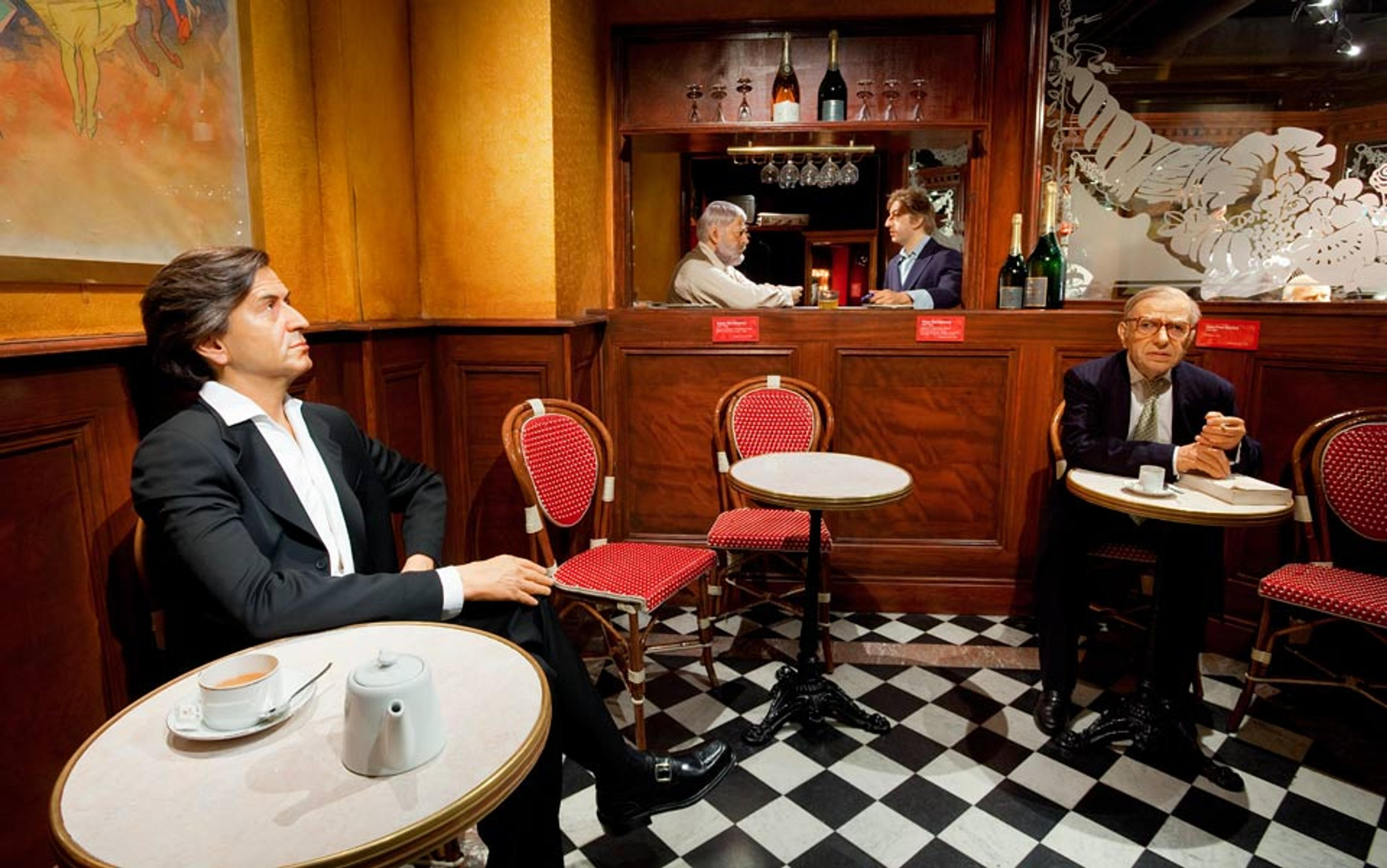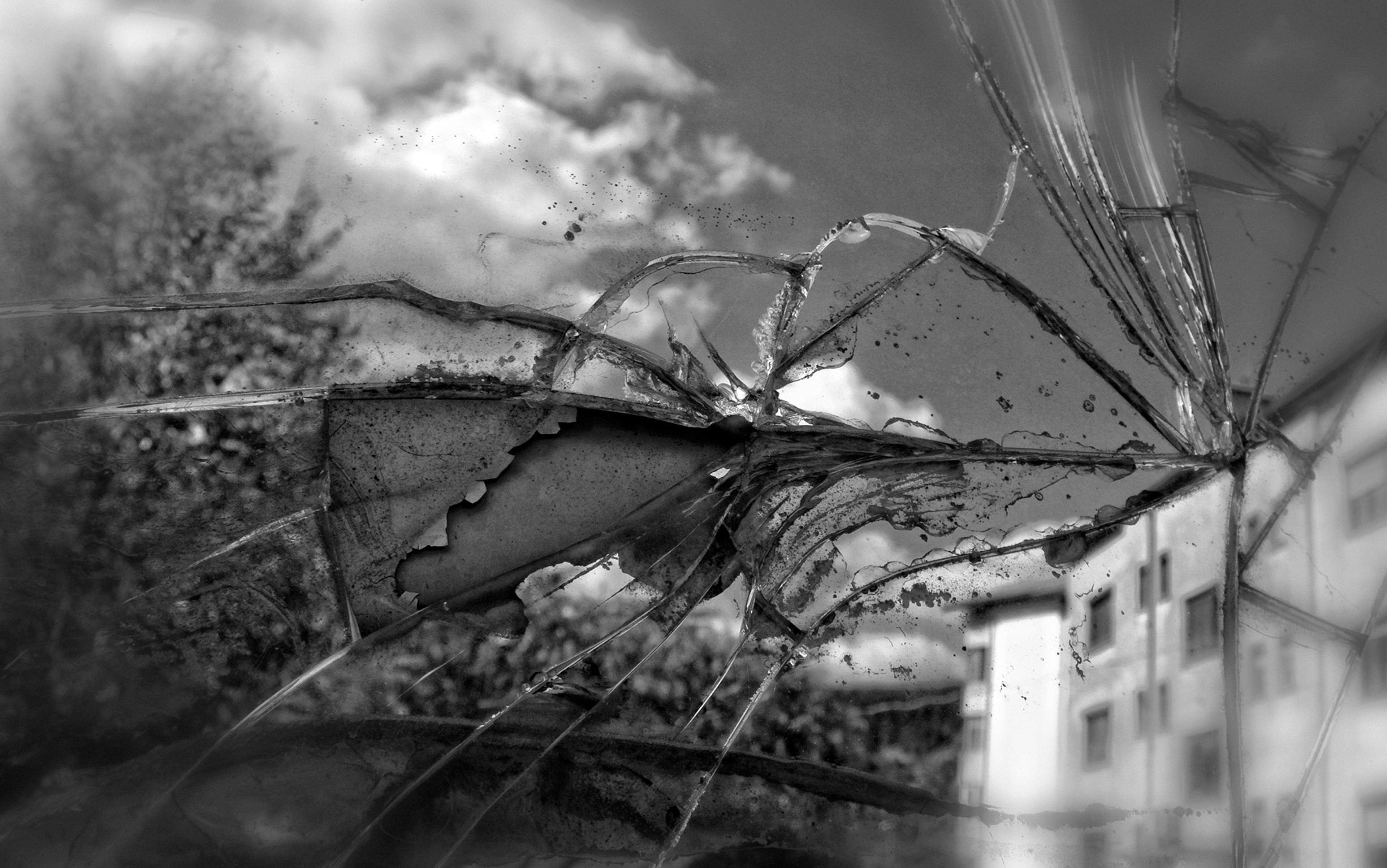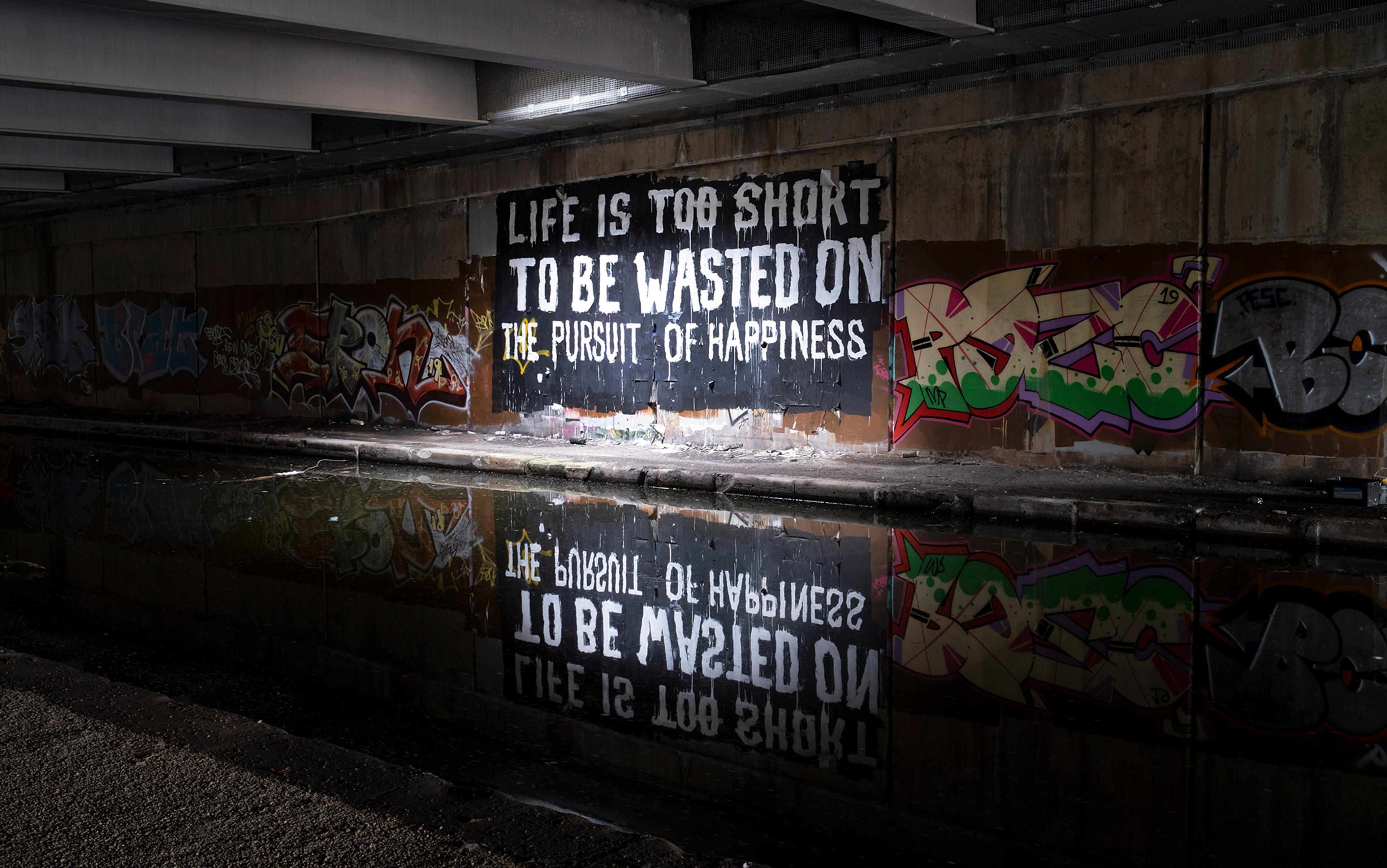On 30 March 1929, the German philosophers Rudolf Carnap and Martin Heidegger took a stroll together around the chilly heights of Davos in Switzerland. Heidegger was 39 and ascending to the peak of his fame. Two years earlier, he’d published Being and Time, a book that tried to say something about what it means for something ‘to be’, and therefore about the nature and necessary conditions of being human. It also gained near-instant notoriety for its indigestible prose and bewildering neologisms. (His most notorious: ‘ahead-of-itself-already-being-in [a world] as Being-alongside [entities encountered within-the-world]’; mercifully, he shortened this concept to ‘care’). Whatever its flaws, the book unquestionably revolutionised philosophy.
Carnap, a year and a half younger than Heidegger, was respectful to his more accomplished compatriot. He hadn’t yet read Being and Time, although he did the following year, bragging that his friends ‘were astonished that I was capable of interpreting Heidegger’. Carnap even wrote of Heidegger that he is ‘as a person very attractive’, which doesn’t appear to be a widely shared impression. By all accounts, Heidegger was arrogant, humourless, ugly and disloyal. His affectations made contemporaries groan: he occasionally dressed like the peasant he wasn’t, or else showed up to lectures wearing his skiing outfit.
The Alpine conversation turned to the ‘question of existence’ and the ‘need for a solution’, two enduring obsessions of Heidegger’s. But Carnap was determined to claim intellectual territory of his own, having recently taken his own first steps up the mountain of philosophical recognition. The year before, he’d published his first important work, The Logical Structure of the World (1928), and helped to write a manifesto for his cohort of thinkers, the Vienna Circle. These texts announced a philosophical revolution in which a new methodology based on logical analysis would finally put philosophy on firm footing.
Davos was perhaps the last moment in which the two men were thinking together, figuratively or literally, on the same plane. In 1932, Carnap unleashed a cutting attack against Heidegger, denouncing him as a ‘musician without musical ability’ – a stinging insult for someone who considered himself to be investigating the most profound philosophical questions imaginable. Then in 1933, Heidegger enthusiastically joined the Nazi Party. At times, he even seemed to imagine himself as some kind of philosopher-kaiser, and he never recanted. Carnap, a declared socialist, ultimately fled fascism and found refuge in the United States.
But the divergence between these men was not purely a personal matter of moral and political mettle. Where Heidegger’s and Carnap’s views came together, and where and why they fractured, illuminates two radically opposing ways of doing philosophy. This dispute cleaved Western thought in two, and continues to reverberate to this day. Does philosophy begin from a place of awe, with its sights trained on trying to describe the clamour and confusion of what it’s like to be alive? Or is it the precise, sober and rational pursuit of truth, in which we eke out logical, painstaking arguments in order to achieve scientific clarity about how the world really is?
Shortly after the meeting in Davos, Heidegger delivered a dense and rather bewildering lecture entitled ‘What is Metaphysics?’ His goal was to enquire into capital-B ‘Being’. That is, he wanted to think about what existence itself is – what ‘Being as such’, in his words, is – and how we humans experience that existence. These investigations go to the very foundation of what it means to do philosophy. In order to do this, he attempts to invoke a sense of philosophical shock that will deliver a new (Heidegger would say more ‘primordial’) perspective on what it is to be a human being. As one attendee said after the lecture: ‘I felt as though for a moment I had gazed at the foundations of the world.’
That is the kind of reaction Heidegger strove for: to dislodge his listeners from their complacent philosophical attitudes, to question assumptions so extraordinarily basic that they often go unexamined. He wanted to point to what is too close to be seen. This style of thinking has been called ‘event philosophy’. It is crucial to his outlook and to his split with Carnap that what he often aims for is instilling a moment of philosophical wonder, using a spark of existential discomfort to prompt astonishment at the fact that we exist.
Heidegger’s starting point is that each of the sciences, which he understands (very) broadly to include everything from mathematics to history, concerns itself with a particular set of things in the world. Fine: that’s pretty indisputable, even platitudinous. But the next move is more troubling. Each of the sciences concerns itself with a particular set of things that exist – and nothing more. And here’s where things become highly disputable. Heidegger then asks:
But what about this ‘nothing’? Is it only an accident we speak like that quite naturally? Is it only a manner of speaking – and nothing more?
This slightly mad query launches Heidegger into a discussion of the Nothing. ‘If science is right then one thing stands firm: science wishes to know nothing of Nothing,’ he writes. That is, the objects of scientific enquiry, whatever they are, are the only things that the scientist is interested in – and nothing else. Heidegger is playing on this phrase ‘nothing else’ and reifying it into the Nothing. Scientists want to know about some things, not the Nothing.
The problem is that the moment we begin to try to grasp at this ‘Nothing’, it slips away from us. If we try to say something about the Nothing, we would be saying ‘the Nothing is…’ – which would be contradictory, because the Nothing isn’t something. It isn’t anything. Logic itself precludes any further enquiry into Nothing. Logic is the supreme arbiter: it shuts off our way forward, it closes the conversation, it ends our playtime. It indicates that which we must pass over in silence.
But of course Heidegger doesn’t step down from the lectern at this juncture. He has an awful lot to say about Nothing, though not directly; but by indication, gesture, allusion – and most of all, by way of his weird and frustrating coinages. Logic will not stand in his way; logic, says Heidegger, is not ‘the highest court of appeals’. His point is that humans can understand things in ways that aren’t strictly intellectual. In our day-to-day lives, we talk about ‘nothing’ all the time. (‘What did you do in school today?’ ‘Nothing.’) We can use the concept in this way because we have a pre-theoretical idea of what ‘nothing’… is, Heidegger says. Getting to this ‘pre-theoretical’ place is the very heart of his philosophy as a whole. It means going ‘beyond’ logic, or perhaps ‘behind’ it, to appeal to the what-it-is-like-ness of being a person. Heidegger wants to show – but not really to argue for – the idea that logic doesn’t exhaust what we can meaningfully say about existence.
It is through moods such as boredom, joy or anger that the world ‘discloses’ itself to us, as Heidegger says
This mode of doing philosophy has intuitive appeal. As you go about your day – waking up, arguing with your spouse, working, reading, eating, asking your spouse for forgiveness, etc – do you really theorise about those activities as you do them? For the most part, you probably don’t experience your own actions with cool disinterest, analysing the beliefs that underpin your intentions, and examining how the various parts come together to form the whole. Instead, you cope with the task at hand, just getting on with things without asking yourself what it is, in fact, you’re actually doing (though we all have those reflective moments, too). And when you’re coping with the things of the world, your experience is always filtered through moods, Heidegger says, rather than via conceptualising thoughts. In fact, the actions themselves hardly need to be thought about, and tend to become more difficult if you give yourself over to contemplation of them.
For Heidegger, all this means that philosophers should pay attention to people’s moods and activities, rather than trying to construct big, complicated theories (though this is much of what he does in Being and Time). For life is lived through feelings that are not, in themselves, intellectual. It is through moods such as boredom, joy or anger that the world comes to us, or as Heidegger says, ‘discloses’ itself to us. The ‘theoretical attitude’ – which most philosophers assume is the starting point of their work – is actually the exception. It’s always a step or two away from actual, lived experience. The thoughtless endorsement of the theoretical attitude, Heidegger says, obscures what it is to be, which he takes to be the real purpose of philosophy.
Now for the twist: the reason we can toss ‘Nothing’ about so easily – the reason why we have an inkling of ‘Nothing’ even if we can’t directly speak about it – is that there’s a particular mood that ‘discloses’ the Nothing. That mood is anxiety. While fear tends to have a singular object, like a vengeful spider or a murderous clown, anxiety lacks a target. It shears away meaning, revealing the pointlessness of it all, the utter, hollowed-out barrenness of existence. When we hear the telephone ring, it isn’t anxiety that makes us pick up, or wonder idly who’s calling; it is what makes us ask why anyone would bother calling anyone at all, as the American philosopher Hubert Dreyfus put it. It’s akin to the experience of the character Roquentin in Jean-Paul Sartre’s novel Nausea (1938):
the naked World suddenly reveal[ed] itself, and I choked with rage at this gross, absurd being. You couldn’t even wonder where all that sprang from, or how it was that a world came into existence, rather than nothingness. It didn’t make sense, the World was everywhere, in front, behind. There had been nothing before it. Nothing.
In the full bloom of anxiety, the world is suddenly made to seem brittle and inessential. It discloses for us the true, dread meaning of ‘Nothing’. In Heidegger’s words, anxiety ‘induces the slipping away of beings as a whole’. As the German philosopher Rüdiger Safranski elucidated in 1998:
This ‘slipping away’ is cramping and draining at the same time. Draining because everything loses its meaning and becomes null and void. Confining because the void penetrates into the feeling of self.
But then Heidegger does something unexpected. This anxiety, this thrashing within and against the meaninglessness of the world, and the homelessness of our peculiar place in it, actually brings forth a brilliant thing: astonishment. Astonishment that we are here, asking these questions. Through anxiety, Heidegger says, we come to appreciate afresh the extraordinary fact that the world exists. Anxiety opens up a vista on much of what it means to be alive. In the end, we return to the most basic puzzle of all, which is the seed of philosophy: ‘Why is there any Being at all – why not far rather Nothing?’
Carnap didn’t agree. He had come to believe that Heidegger was puffed-up, inexact and hand-wavey. To demonstrate this, Carnap wrote the broadside ‘The Elimination of Metaphysics through the Logical Analysis of Language’ (1932). He lifted some particularly thorny sentences from Heidegger’s lecture, and used them as an example of the bankruptcy and obscurantism of metaphysical thinking. Heidegger became the poster boy for bad philosophy: vague, meandering and meaningless.
To Carnap – and many others – much metaphysical thought was bullshit. To put a slightly finer point on it, Carnap thought that most of what philosophers do when they write about metaphysics is compose semantically empty sentences, which he calls pseudostatements. Sentences of this metaphysical flavour appear to say something profound, since they are grammatically correct. But careful investigation reveals that, not only is nothing profound being said, nothing is being said at all. And philosophers, Carnap believed, should say things that are meaningful.
The test for meaningfulness fashioned by Carnap and the Vienna Circle is called the principle of verification. By submitting sentences to this test, we can tell which are meaningful statements and which are empty pseudostatements (perhaps only fit for the flames, as the 18th-century Scottish philosopher David Hume believed was the proper destination of all metaphysical works).
There are two approaches to the principle of verification: logical (or ‘formal’) and empirical (or ‘connotative’). In the former case, Carnap says that ‘the syntax of a language specifies which combinations of words are admissible and which inadmissible’. For instance, sentences in which predicates are inaptly applied to a subject are meaningless: ‘John Major is a prime number’ is logically meaningless.
Wielding his scythe of logic, Carnap hacks away at Heidegger
In the second case, empirical verification requires that sentences must be capable of being shown to be true or not. For example, the sentence ‘Human babies have 300 bones and human adults have 206 bones.’ This is meaningful because it can be verified by examining the number of bones in a baby and the number of bones in an adult; given the sense-data and the definition of ‘bone’, we can say that it is indeed the case (our bones fuse as we age). Or take the sentence ‘All people have heads larger than an ox.’ This too is subject to the principle of verification, in that we can look at the heads of people and the heads of oxen, and see that it is false; oxen have giant heads. However, it is still meaningful. Meaningless, then, doesn’t mean ‘false’: fairy tales, as Carnap says, are perfectly meaningful despite being false. Rather, ‘true’ and ‘false’ are beside the question when it comes to meaninglessness. They simply don’t apply. According to Carnap, the principle of verification demonstrates that metaphysics (as well as ethics) consists of pseudostatements: they mean nothing at all.
Carnap’s broader project was to redefine philosophy itself. He wanted to make it a ‘logic of science’, and dissolve many philosophical problems by demonstrating that they only appeared to be problems. Logical analysis – as well as an ideal logical language – would cut away at the messiness of how we use words in everyday speech, purifying them and making them clear. In the end, most philosophical problems will disappear in the solvent of logic, shown to be non-problems caused by abuses of language. And why wouldn’t we want to do that? There have always been philosophers spewing strange but beguiling nonsense. So the idea of devising some kind of method to make sure that we don’t or can’t do that anymore, to hitch philosophy’s development to the mast of science – what’s not to like?
Wielding his scythe of logic, Carnap hacks away at Heidegger. All sentences containing the phrase ‘the Nothing’ are shown to be meaningless. As noted above, to use ‘nothing’ as a noun and to say that it ‘is’ something is nonsensical – ‘the existence of this entity would be denied in its very definition,’ Carnap writes. Carnap sees that Heidegger appreciates the objection that sentences about Nothing fly in the face of logic. But this doesn’t curb the severity of his critique, or prevent him from extending it to a host of other intellectual delinquents: Johann Gottlieb Fichte, Friedrich Schelling, G W F Hegel and Henri Bergson. Logical analysis and the principle of verification, Carnap believes, represent a revolution in what it means to say something meaningfully.
After reading Carnap’s paper, Heidegger was dismissive. He didn’t deign to respond publicly. But he did comment privately that his counterpart believes ‘truth is rather diverted into certainty – to the mere securing of thought, and in fact the securing of mathematical thought against all that is not thinkable by it.’ Funnily enough, Carnap would probably have agreed.
Perhaps it takes a mind as subtle as Ludwig Wittgenstein’s to really, truly understand Heidegger. After reading Heidegger’s lecture, Wittgenstein remarked:
To be sure, I can imagine what Heidegger means by being [Sein] and anxiety [Angst]. Man feels the urge to run up against the limits of language. Think for example of the astonishment that anything at all exists. This astonishment cannot be expressed in the form of a question, and there is no answer whatsoever. Anything we might say is a priori bound to be mere nonsense. Nevertheless we do run up against the limits of language.
Much of the disagreement between Heidegger and Carnap boils down to the notion of ‘limits’: the limits of words, the limits of knowledge, the limits of expression. And limits naturally prompt questions about beginnings: where to start when we do philosophy, and how does that starting point influence wherever we might be headed? In logic, Carnap found firm ground from which to launch his own philosophy, and to articulate the kind of thinking that should be classed as truly ‘philosophical’. For Heidegger, logic is useful but not sufficient. There is so much more to say, so much more to question, so much more bound up with the business of being alive.
With logical analysis, Carnap was convinced that he’d developed a tool that ‘radically’ eliminated metaphysics. But even if we grant that metaphysics is meaningless, then what is it that philosophers have been doing all these years? Where’s the enduring attraction that’s sustained all these centuries of supposedly meaningless sputtering? How could everyone have been conned? It’s here that we find a surprising convergence between Carnap and Heidegger.
In Carnap’s view, metaphysics is an ‘expression of the general attitude of a person towards life’. There’s an essential need in humankind to try to articulate the feelings they have about existence. We often find ourselves frustrated, occasionally victorious, but never fully complete or satiated. Every human being, Carnap says, has an attitude towards ‘the tasks to which he devotes himself, to the misfortunes that befall him’. We express this attitude through music, painting, poetry – in fact, through all great artistic endeavours. Metaphysics, and indeed much of what is traditionally understood to be ‘philosophy’, is of a piece of this expressive drive. What irks Carnap about metaphysics is the hypocrisy, the fact that ‘through the form of its works it pretends to be something that it is not’. Metaphysics doesn’t operate in practice like poetry; metaphysicians think they’re theorising about the world in a way that poets know they aren’t.
The truth is that Heidegger and Carnap are closer to one another than they first appear. Heidegger would accept something of this similarity between philosophy and poetry. But he doesn’t see it as a problem; Carnap does. Carnap’s vision of philosophy is for it to be airtight and true. He wants to think and speak with the utmost certainty, and logic is the means by which to do that.
Life ‘happens’ in the ellipses – the fact that there is an ellipsis means there’s something to be said about it
For Heidegger, it’s the task of philosophy to take up the challenge of describing what existence is, what being itself is. That requires us to bend our thinking beyond the narrow constraints of language and logic, and to accept that plumbing the depths of existence requires more than language and logic. ‘The very idea of “logic” disintegrates in the vortex of a more original questioning,’ wrote Heidegger.
So it’s always worth trying to say something about the unsayable. Indeed, according to Isaiah Berlin, this is what profundity itself is. When it comes to the analogous subject of profundity in art, he wrote:
the more I say the more remains to be said … as soon as I speak it becomes quite clear that, no matter how long I speak, new chasms open. No matter what I say I always have to leave three dots at the end. Whatever description I give always opens the doors to something further, something even darker, perhaps, but certainly something which is in principle incapable of being reduced to precise, clear, verifiable, objective prose.
Life ‘happens’ in the ellipses. And Heidegger holds that we should nonetheless try to say something about the ellipsis – that the fact that there is an ellipsis means that there’s something to be said about it. Not directly, perhaps, and not even particularly clearly. But that doesn’t mean we should abandon all efforts to use words to speak about things that lie beyond them. Indeed, to smother that desire goes against every human instinct sparked by the wonder we feel at being alive.
The gaps or ellipses that interest Heidegger – that feeling of ‘more than’ – is revealed in strange and almost inconceivable moments. Arthur Schopenhauer felt it on mountaintops at dawn. Friedrich Nietzsche was struck by it at his summer house in Sils Maria in Switzerland. These moments, akin to the idea of ‘peak experience’, aren’t just the property of rarefied philosophers. In prison in the early 1980s, the great Czech writer, dissident and statesman Václav Havel looked at a tree beyond his window, and that was enough to trigger a transcendental moment. He wrote in his diary:
As I watched the imperceptible trembling of its leaves against an endless sky, I was overcome by a sensation that is difficult to describe: all at once, I seemed to rise above the coordinates of my momentary existence in the world into a kind of state outside time in which all the beautiful things I had ever seen and experienced existed in a total ‘co-present’.
Bertrand Russell, who wasn’t terribly enamoured of such pseudo-Romantic flights of fancy, nevertheless captured something of this idea when he wrote about mystical ‘insight’ in 1914:
There is, first, the belief in the insight as against discursive analytic knowledge: the belief in a way of wisdom, sudden, penetrating, coercive, which is contrasted by the slow and fallible study of outward appearance by a science relying wholly upon the senses … Mysticism is to be commended as an attitude towards life, not as a creed about the world.
That is the side that Carnap came down on in his own musings on the ‘attitude towards life’. He doesn’t think that it’s philosophy’s responsibility to deal with any such ‘ellipsis’ (whatever that is), and understandably so, for this path risks such deep uncertainty, such chaotic illogic. That kind of thing is for the poets, not for sober seekers of truth and wisdom.
Carnap believed that there must be a way of separating out nonsense and wilful obscurity from rigorous and honest thought. To that end, philosophical thinking needed to be exact; to crib Russell again, it is arduous and piecemeal and anything but glittery. Philosophy is the difficult and slow practice of constructing theories about the way that the world is, and speaking clearly when we explain them. By contrast, if philosophy stems merely from sublime Heideggerian moments, from describing and interpreting what it is like to be alive, from divesting oneself of the need for empirical confirmation – then isn’t anything allowed?
Something else that Carnap and Heidegger had in common was a certain grandiose blindness to the limits of their own approach. Take Carnap’s project of making philosophy the ‘logic of science’ (or in A J Ayer’s formulation, ‘philosophy is a department of logic’). All that philosophers can do is clarify certain (often scientific) concepts. That’s a rather dispiriting mission statement. Even if this were to come to pass, surely we’d feel there’s much still to do. As Wittgenstein noted in the Tractatus (1921) – after assuming that he, like Carnap, had resolved all the major problems of philosophy: ‘the value of this work … is that it shows how little is achieved when these problems are solved’. Perhaps something similar could be said about Carnap’s project – indeed, about all radically deflationary philosophical projects.
The disappointment on Heidegger’s side, though, is that we’re forced to give up something equally precious: knowing things for certain. This is the exhilarating, even moving, notion that a correct and universally acknowledged way of doing philosophy can one day be found, allowing us to peer beyond the veil at the deep architecture of reality. If we accept the idea that philosophy is, baldly put, an interpretation of life, then it seems that we have to bid farewell to the search for an agreed-upon methodology that will lead, in the end, to truth.
It is by such proposals and challenges – by such failed revolutions – that philosophy itself progresses
Both Carnap and Heidegger’s views shifted as they aged. Carnap and the Vienna Circle’s revolution failed for the same reason that many philosophical revolutions do: they were undone by their own assumptions. That’s rendered most vivid in the stubborn fact that the principle of verifiability could not itself be verified, at least not according to the principle’s own standards. But it is by such proposals and challenges – by such failed revolutions – that philosophy itself progresses. By the time that Carnap died in California in 1970, at the age of 79, he was widely recognised for his courage and ambition in trying to install philosophy on firmer methodological ground.
Heidegger’s trajectory was less happy. After joining the Nazi Party in 1933, he tried to fit his oeuvre into what he understood to be the project of National Socialism. The result is a bizarre ‘philosophical somersault into primitivity’, as Safranski put it. In 1966, in the final chapter of his life, Heidegger was interviewed by the German newspaper Der Spiegel, long after the full picture of the death camps became common knowledge. But instead of repenting, Heidegger urged his interviewers to be more precise about the way in which he’d engaged with National Socialism. Because of Heidegger’s Nazism, his philosophy has forever been tainted; even so, his contribution to the millennia-long conversation about the fundamentals of the world, the nature of being and the essence of humanity can still trigger moments of uncanny philosophical recognition.
Heidegger’s and Carnap’s styles of thinking and communicating were, to put it mildly, profoundly different from one another. Within that difference, we glimpse the openings of a widening chasm that defined Western philosophy in the 20th century, setting apart two methods or styles of philosophy that are commonly called the analytic and Continental traditions (the story of which is taken up by Michael Friedman in A Parting of the Ways: Carnap, Cassirer, and Heidegger [2000]). But regardless of this divergence, both Heidegger and Carnap believed themselves to be doing philosophy – even when the question of what philosophy is, and the methods by which it should be conducted, was itself at the centre of philosophical disagreement.
Perhaps what unites philosophy of all stripes is that its practitioners are likely to run up against the limits of language. We have no other option but to use language – broadly understood – to communicate philosophical ideas; yet we always try to go beyond it, because it always seems like there’s something more to say. To my mind, that’s because the central event that ignites any interrogation about humanity’s place in the world and who we are comes from an inexhaustible well of wonder. That wonder can arise in many different forms, and it can be experienced in as many different ways as there have been thinking people on the Earth. But in its most fundamental form, its most universal articulation, its most profound rendering, the wonder from which philosophy springs is perhaps best wrought by the immortal, unanswerable, unquenchable question: why is there something rather than – …






